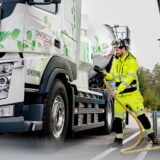South Korea’s Kia Motors unveils “green car” roadmap
South Korea’s Kia Motors Corp. unveiled its mid- to long-term plans to expand its range of environmentally friendly vehicles. The brand’s “green car roadmap” sets out Kia’s ambition to become a leader in the low emissions car market by 2020.
It is anticipated that the five-year development plan will see Kia further increase its investment in research and development (R&D) into fuel-efficient technologies and new products, with a range of all-new models and highly advanced powertrains for global markets.
The new investment by Hyundai Motor Group, Kia’s parent company, totals KRW 11.3 trillion (USD 10.2 billion), to develop a range of new eco-friendly models and building the facilities required for the brand’s efforts to further reduce its CO2 output. The investment is likely to result in the creation of thousands of new jobs in domestic R&D positions.
“Global market demand is shifting to electric vehicles, with oil prices predicted to rise in the future. The electric and plug-in hybrid vehicle market will grow rapidly in the coming years, and this investment will enable Kia to meet the growing demand with a range of advanced new products and technologies,” said Ki-Sang Lee, senior vice president, Eco Friendly Vehicle R&D Center.
“We don’t believe that there is any one ‘silver bullet’ that can satisfy the demand for low emission technology within the car industry, so we foresee a wide range of eco-friendly powertrains co-existing for an extended period of time. The plans we’ve announced today represent Kia’s ambition to become a worldwide leader in advanced propulsion technology,” he said.
By 2020, Kia’s current green car line-up is expected to grow from four current models to 11. This expanded range of environmentally-friendly vehicles will encompass a wide range of advanced powertrains, from hybrids and plug-in hybrids to battery-electric and fuel cell electric vehicles.
The first models to be launched featuring new types of powertrains under the brand’s 2020 vision for low emissions cars will be the Kia Optima PHEV (plug-in hybrid electric vehicle), which will feature a high capacity lithium-polymer battery pack and electric motor, as well as an efficient six-speed automatic transmission, and the Niro hybrid utility vehicle (HUV), which will target CO2 emissions of 90 g/km (combined, based on the New European Driving Cycle).
As part of this five-year plan, Kia is targeting a 2020 launch for mass production of an all-new hydrogen fuel cell vehicle, featuring next-generation hydrogen fuel stack technology. Kia is working alongside 300 partner companies to develop the next-generation FCEV technology for global markets. Production of the new Kia FCEV is aimed to be around 1,000 units per year, a figure which is expected to rise as demand for fuel cell vehicles increases.
These plans will help Kia in its aim to raise its average corporate fuel efficiency by 25% over 2014 levels by 2020. As well as investment in advanced propulsion technologies, Kia will also replace seven out of its 10 current engine ranges with next-generation gasoline and diesel units, while increasing the number of turbocharged engines. Higher-efficiency, multi-speed transmissions are also planned, while Kia engineers are targeting a 5% reduction in the average weight of new car bodies through greater application of ultra-high strength steel.
The investment by Kia’s parent company, Hyundai Motor Group, into the development of highly-advanced, highly-efficient powertrain technology as well as smart car technology is expected to create more than 7,300 new jobs, predominantly in R&D roles, over the next four years. Additional job creation is also expected through ongoing investments into the company’s R&D and production facilities, with new overseas Kia production facilities also generating new jobs, directly and indirectly.














